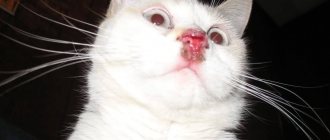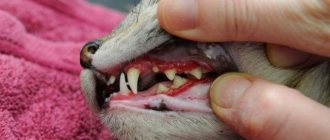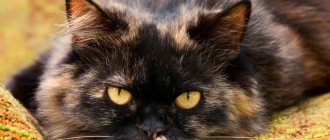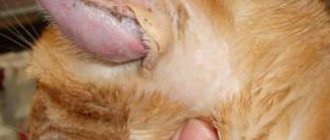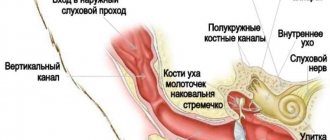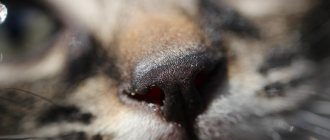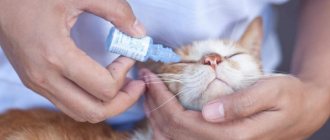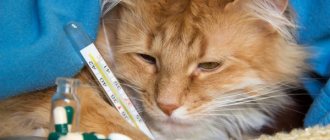Is nasal discharge a cause for concern?
If your cat's sneezing and/or nasal discharge is minor and she has a normal appetite and activity level, you just need to monitor her condition. To be on the safe side, it is better to isolate a cat with a “running” nose from other animals.
Chronic nasal discharge is a common symptom of viral and bacterial infections and should be taken seriously. However, most often, nasal discharge is associated with food or seasonal allergies.
Diagnostic methods
Rhinitis is diagnosed by nasal congestion, discharge and sneezing. Diagnosing the root causes is becoming more difficult:
- You need to collect a complete medical history, which is almost impossible if you adopted a cat from a shelter or adopted it on the street.
- If the symptomatic picture and tests are not enough, the veterinarian conducts a full examination (the cat is first placed under anesthesia).
During the examination, the veterinarian must ensure that:
- The cat does not have congenital defects in the structure of the skull and nose.
- There is no fistula in the septum between the nose and mouth.
- There are no foreign objects in the cat's nose.
Because nasal congestion can be caused by swelling and injury, your doctor may recommend an X-ray or MRI.
Allergic rhinitis in cats
If you observe watery discharge accompanied by sneezing, it usually means your cat has ingested or inhaled an allergen from the environment. Allergies to non-food irritants, also known as atopy, were most likely inherited by your cat from her parents.
Note! Atopic allergy is an increased sensitivity to common allergens: plants and their waste products, mold, insect bites and dust mites, etc.
Nasal congestion: how to help your cat
A method to help a cat breathe better, also used by us humans, is to use water vapor to help remove mucus.
Obviously, you should not place your cat's head on a bowl of hot water, as the cat may get burned or scalded if it hits the basin. But it would be enough to prepare a steam bath by turning on the hot water of the shower and allowing the cat to enter the steamy environment for 10 minutes, keeping it away from the water.
Additionally, although the cat's nose is blocked, it is necessary to clear it by soaking a cotton swab and running it under the cat's nose. Finally, you need to contact your veterinarian, who will decide whether to subject your furry friend to antibacterial therapy or prescribe a mucolytic drug.
Viral or respiratory diseases in cats
Thick and mucous discharge is a sign of a respiratory infection. It is important to understand that there are a lot of such infections and the diagnosis must be made by a veterinarian.
Viral diseases of cats that cause rhinitis:
- Actinomycosis.
- Viral peritonitis.
- Hemobartonellosis.
- Viral immunodeficiency.
- Calicivirus.
- Giardiasis.
- Mycoplasmosis.
- Panleukopenia (distemper).
- Parvovirus.
- Rhinotracheitis or herpes virus infection.
- Chlamydia.
A bacterial infection can cause chronic nasal discharge. If the discharge is thick, yellow and has an unpleasant odor - a bacterial infection, this is the most likely diagnosis.
Treatment of sinusitis with nasal rinsing
Diagnosis of sinusitis
The reason for taking measures to diagnose sinusitis is the patient’s complaints about the symptoms of the disease.
Before the examination, the otolaryngologist interviews the visitor and conducts an instrumental examination. Methods for diagnosing sinusitis:
- Endoscopy. Examination of the nasal sinuses using a miniature camera inserted through the respiratory tract. Allows you to examine the condition of the mucous membrane in places inaccessible to the naked eye.
- X-ray. The procedure allows you to assess the condition of bones and soft tissues with high accuracy. Shows fluid accumulation and swelling.
- CT scan. Prescribed in cases where accurate detailed information is needed to make a diagnosis and prescribe treatment for sinusitis.
- Puncture. Puncture of the nose to obtain biomaterial and conduct bacteriological research. It may be required if treatment is ineffective and in a number of other cases.
Methods for diagnosing sinusitis are determined by the doctor on an individual basis.
Treatment of sinus inflammation
Today, there are several ways to treat sinusitis. It is important that the appointment is made by an experienced ENT doctor. Since the same methods show different effectiveness for certain types and stages of the disease and in some cases can do more harm than good.
Main types of therapy:
- medicinal;
- physiotherapy;
- folk
Separately, it is worth highlighting the procedure for rinsing the nose for sinusitis. It is suitable for any form of disease, has virtually no side effects and shows excellent results in combination with other methods. In especially severe cases, sinusitis is treated with surgery - sinus puncture or puncture, endoscopic sinus surgery.
Drug treatment of the disease
Various medications and drugs are widely used in the treatment of sinusitis. They are prescribed both to eliminate symptoms and alleviate the patient’s condition, and to influence the cause of inflammation. They can be used independently or in combination with procedures.
The main groups of drugs for the treatment of sinusitis:
- Decongestant nasal sprays. Promotes easier breathing and better removal of mucous secretions.
- Antibiotics. Prescribed for the treatment of purulent sinusitis and the development of bacterial infection.
- Hormonal agents. Glucocorticoids are highly effective in cases where sinusitis is caused by allergies.
Medicines must be prescribed by a doctor. Catarrhal, purulent, mixed sinusitis require different treatments. In addition, when choosing medications, the otolaryngologist takes into account the patient’s condition and many other factors.
Nasal rinsing for sinusitis
Nasal rinsing is one of the most effective procedures in the treatment of sinusitis. If you follow the rules, it is safe and brings relief within a few minutes. The essence of rinsing is the introduction of drugs through a nostril, followed by their movement in the sinuses and removal through the other nostril.
Thanks to the washing procedure:
- mucus and pathogens are removed;
- the nasal passages are washed and breathing becomes easier;
- sinuses are treated with medications;
- the likelihood of complications is reduced;
- the inflammatory process decreases.
Nasal rinsing for sinusitis under the supervision of a doctor can be done even for children. In clinics, the Proetz (cuckoo) method is used for this. It helps both in the initial stages of sinusitis and after complications of the disease appear. At home, a water-salt solution is used. For sinusitis, rinsing is done by inhaling liquid from the palm of your hand.
Inhalation with a nebulizer
Nebulizer inhalations for sinusitis are used along with nasal rinsing. This is a hardware method based on the principles of air aeration. During the procedure, the patient inhales evaporated air containing the drug.
Features of treating sinusitis with a nebulizer:
- simplicity and convenience;
- safety and painlessness of the procedure;
- penetration of the drug into the sinuses;
- impact on the cause of the disease;
- rapid relief of sinusitis symptoms;
- removal of edema.
The use of a nebulizer is possible at home, both in complex therapy and for prevention. If you have sinusitis, you should consult a doctor so that he can prescribe a medication suitable for the procedure and rule out complications of the disease.
Features of treatment of sinusitis during pregnancy
During pregnancy, women have an increased risk of developing sinusitis. This occurs due to increased stress on the immune system and hormonal changes. At the same time, sinusitis is dangerous due to fetal hypoxia and various complications, and treatment methods are limited.
Pregnant women are recommended:
- contact the clinic when the first symptoms appear;
- carry out procedures for rinsing the sinuses;
- use a nebulizer.
Treatment of sinusitis during pregnancy must be carried out by a doctor to avoid complications. Diagnosis is usually limited to instrumental examination - rhinoscopy. Puncture under local anesthesia and gentle antibiotic therapy for sinusitis are possible.
Prevention of sinusitis
Prevention allows you to avoid sinusitis and possible complications of this disease.
Effective proven measures:
- prevention and proper treatment of colds;
- strengthening immunity and hardening;
- performing hygiene procedures - washing hands, ventilating the room, etc.;
- annual flu vaccination;
- rinsing the sinuses with pharmaceutical solutions or folk remedies.
If time for prevention has already been missed and the first symptoms of sinusitis appear, you need to contact an ENT clinic. In the initial stages, you can cope with the disease in a short time and at minimal cost.
Treatment at the ENT clinic
In Kemerovo, fast, qualified care for sinusitis and its complications can be obtained at the Euromed ENT clinic.
We provide a full range of services:
- appointment with an otolaryngologist;
- diagnostics using advanced methods;
- treatment of sinusitis;
- nasal rinsing according to Proetz;
- carrying out physiotherapeutic procedures;
- puncture and surgery.
More detailed information about the work of the clinic, otolaryngologists, procedures performed for sinusitis and their cost is available on the EUROMED website. Here you can see patient reviews.
Progression of chronic rhinitis
Regardless of whether the infection is viral or bacterial, the first discharge is watery and thin, and after 24–72 hours it becomes thicker, colored, and may acquire an unpleasant odor. In advanced stages of the disease, purulent discharge is observed.
Common causes of sneezing and chronic rhinitis in cats:
- Upper respiratory tract infection.
- Allergies or irritation of mucous membranes, for example, from smoke, dust, cleaning products, air fresheners, household chemicals.
- Diseases of the oral cavity and teeth.
- Foreign object in the nasal passage, polyps, neoplasms.
The cause of nasal discharge that periodically appears and goes away may be worms. Moreover, there are parasites whose eggs mature in the respiratory tract. The larvae hatch and begin to move, which irritate the respiratory tract, causing coughing, nasal discharge, sneezing and general malaise.
Secondary chronic rhinitis in cats
Cats are created to be unique and versatile. Wild animals keep their senses and teeth constantly clean. Domestic cats receiving an adapted diet do not have this opportunity. It is for this reason that more than 80% of cats over the age of 6 suffer from:
- Caries.
- Tartar.
- Various gum diseases.
Dental problems are a common cause of chronic nasal discharge in cats. Contact your veterinarian if you observe the following symptoms:
- Careful chewing or refusal to eat.
- Salivation.
- "Champing."
- Unpleasant odor from the mouth.
- Discharge from the eyes.
- Cough.
- Temperature increase.
- Ulcerative gum disease.
Another alarming symptom is noisy breathing through the mouth. Most often, open-mouth breathing indicates complete blockage of the nostrils. A similar picture can be observed when:
- Nasal congestion.
- Reporting.
- Neoplasms, including polyps.
Nasal infections can affect both your cat's overall health and her sense of smell. Nasal infections of a viral and bacterial nature can be “identified” by the following symptoms:
- Sneezing.
- Souring of the eyes.
- Refusal of food.
- Fever.
- A sharp decrease in activity.
Copious nasal discharge is observed with the following viral diseases:
- Herpes.
- Rhinotracheitis.
- Plague.
Note! Nasal discharge may be the first symptom of conjunctivitis, as the mucous membranes of the eyes and nose “communicate.”
Causes
Transparent nasal discharge is a reflex reaction of the body to cleanse itself of the following irritants:
- Infectious – viruses, pathogenic bacteria, helminth larvae.
- Non-infectious - foreign objects and allergens.
If fluid comes out of one nostril, it means a mechanical object has entered it. In case of an allergic irritant, both nasal openings remove dust or block access to the mucous membrane of unpleasant-smelling substances - perfumes, gasoline, tobacco. If you remove the object or interrupt the contact of the cat's nose with the irritant, the discharge will stop.
Rhinitis
Otherwise, pay attention to additional signs. They indicate a contagious disease.
If, in addition to nasal discharge, lacrimation or conjunctival hyperemia occurs, contact a specialist. The probable cause of the pathology is cat flu. Unvaccinated young animals, elderly individuals or those weakened by chronic illnesses suffer.
In what cases is the help of a veterinarian needed?
- Sneezing and nasal discharge for 3 or more days.
- Intensive deterioration of the condition - the cat sneezes more often, the nose runs more strongly.
- The color and/or consistency of nasal discharge changes.
- Green, yellow, black, or bloody nasal discharge.
- Itching in the muzzle area.
- Noisy or hoarse breathing, snoring.
- Decreased appetite and activity level.
- Vomit.
- Photophobia.
- Fever.
- Anemia of the mucous membranes.
- Noticeable deterioration in wool quality.
- The appearance of crusts, cracks, scabs on the skin of the nose.
- Discharge from the eyes.
